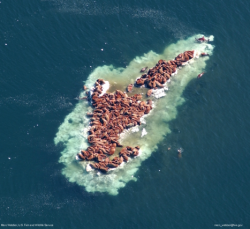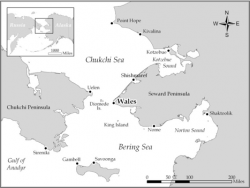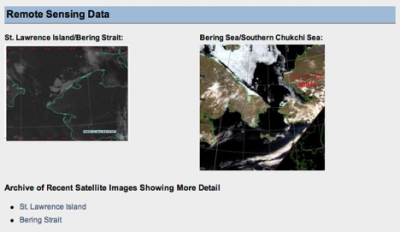The Sea Ice for Walrus Outlook (SIWO) was launched in spring 2010 as a Study of Environmental Arctic Change (SEARCH) pilot project to provide resources for Alaska Native walrus subsistence hunters, coastal communities, and others interested in sea ice and walrus. Weekly reports provided observations and predictions of sea ice and weather conditions for key walrus areas in Alaska.

The Pacific walrus (Odobenus rosmarus divergens) is found throughout the arctic coastal waters of the Bering and Chukchi Seas and is a primary subsistence resource for Native Alaskan coastal communities. Walrus use sea ice as a platform for resting, accessing feeding areas, birthing and nursing calves, and escaping predators. Fluctuations and patterns of arctic sea ice cause Pacific walrus to alter their feeding patterns by forcing them to rest either on land or on sea ice farther from their foraging grounds.
SIWO was initiated as a result of discussions with Alaska Natives in coastal hunting communities. These communities requested an expansion of the SEARCH Sea Ice Outlook to include information specifically relevant to walrus.
SIWO Weekly Reports

A description of current ice conditions relevant to distribution of walrus. Ice conditions were summarized by Gary Hufford, NWS, using satellite imagery, specifically 250-meter visible color Moderate Resolution Imaging Spectroradiometer (MODIS) images from the NASA Terra satellite and 10-meter Synthetic Aperture Radar (SAR) from the Canadian RadarSat satellite. When available, the SAR was especially important because it provided high-resolution imagery independent of weather and light conditions.
A 5- and 10-day outlook of wind conditions. Winds are important for planning walrus hunting activities because wind speeds greater than 20 knots can be dangerous for boats. NWS used numerical prediction models to forecast wind conditions. The North American Model (NAM) was used to look at conditions out to 5 days. The NOAA Climate Prediction Center (CPC) provided guidance to the 10-day timeframe by downscaling their regional monthly climate model to just the St. Lawrence Island and the Bering Strait region.
Up-to-date satellite imagery. Each weekly report linked to daily real-time MODIS imagery provided by the Geographic Information Network of Alaska (GINA) at UAF. At key points in the season, high-resolution SAR images from the Japanese Advanced Land Observing Satellite (ALOS) were provided by the Alaska Satellite Facility and interpreted by the UAF team.

Additional data and resources on ice conditions. Weekly reports also provided links to several additional resources, including: NOAA/NWS ice advisories, sea ice analyses, 5-day sea ice forecasts, sea surface temperatures, NOAA Bering Sea ice maps, and buoy movement data from the International Arctic Buoy Programme (IABP). IABP also provided surface ice/ocean drifters that were deployed by collaborators in Gambell and Wales to track ice movement and surface currents and improve forecasts in the region.
Observations of ice development and other information from Alaska Native hunters, sea-ice experts, or other researchers. A key aspect of the SIWO was the inclusion of near real-time observations and images on weather, sea ice, and walrus locations from Alaska Native hunters in rural communities and sea ice experts in the field. This input, building in part on activities of the Arctic Observing Network, provided rich insights into ice development relevant to marine mammals and people, as well as on-the-ground assessments of the accuracy of NWS model predictions.
Applications of SIWO
The project primarily served local Alaska communities. Subsistence hunters used the wind and ice reports to avoid travel in unfavorable conditions. Curtis Nayokpuk of Shishmaref, Alaska commented that the information enabled local crews to limit trips to the best of weather and sea ice conditions, resulting in safe and successful hunting trips.
One of the challenges for SIWO was making the information in the reports available to people in rural areas. Communities lacking dependable, high speed Internet were unable to access the information through the web. To circumvent this problem, the weekly reports were also sent via facsimile or email to several interested communities, to be distributed among the local residents, and posted in public areas.
The collaborative process for developing the SIWO reports, and the integration of satellite data and numerical models with local observations, could inform and guide other multi-agency collaborations focused on creating science products with direct societal relevance.
Future Plans for SIWO
SIWO organizers are currently discussing options for continuing the SIWO in 2011, contingent on funding. Changes to the product may include a longer reporting timeframe to incorporate whale hunting season, use of higher resolution data, increasing integration of local observations, and additional methods for distributing the reports to rural communities without high-speed Internet access.
For more information, see the SIWO website: http://www.arcus.org/search/siwo or contact Hajo Eicken, Geophysical Institute at UAF (hajo.eicken [at] gi.alaska.edu); Vera Metcalf, Eskimo Walrus Commission (vmetcalf [at] kawerak.org); Gary Hufford, NWS (gary.hufford [at] noaa.gov); or Kristina Creek, ARCUS (creek [at] arcus.org).
Additional information on the Pacific walrus can be found at: http://alaska.fws.gov/fisheries/mmm/walrus/nhistory.htm.
